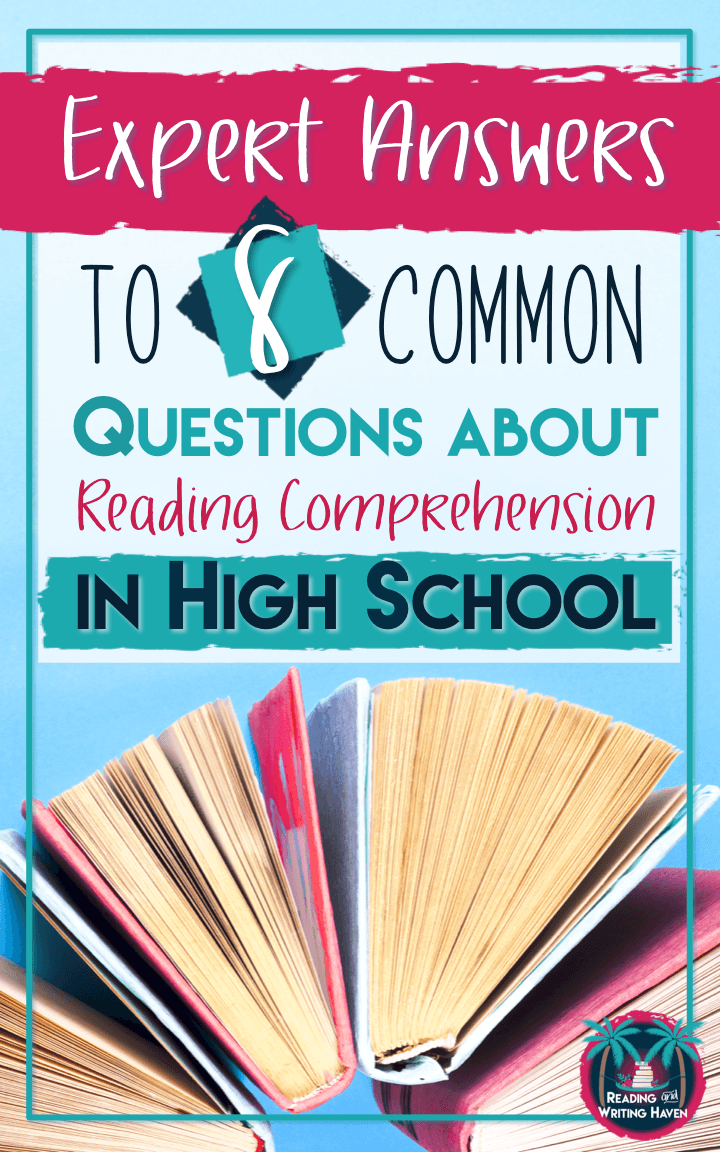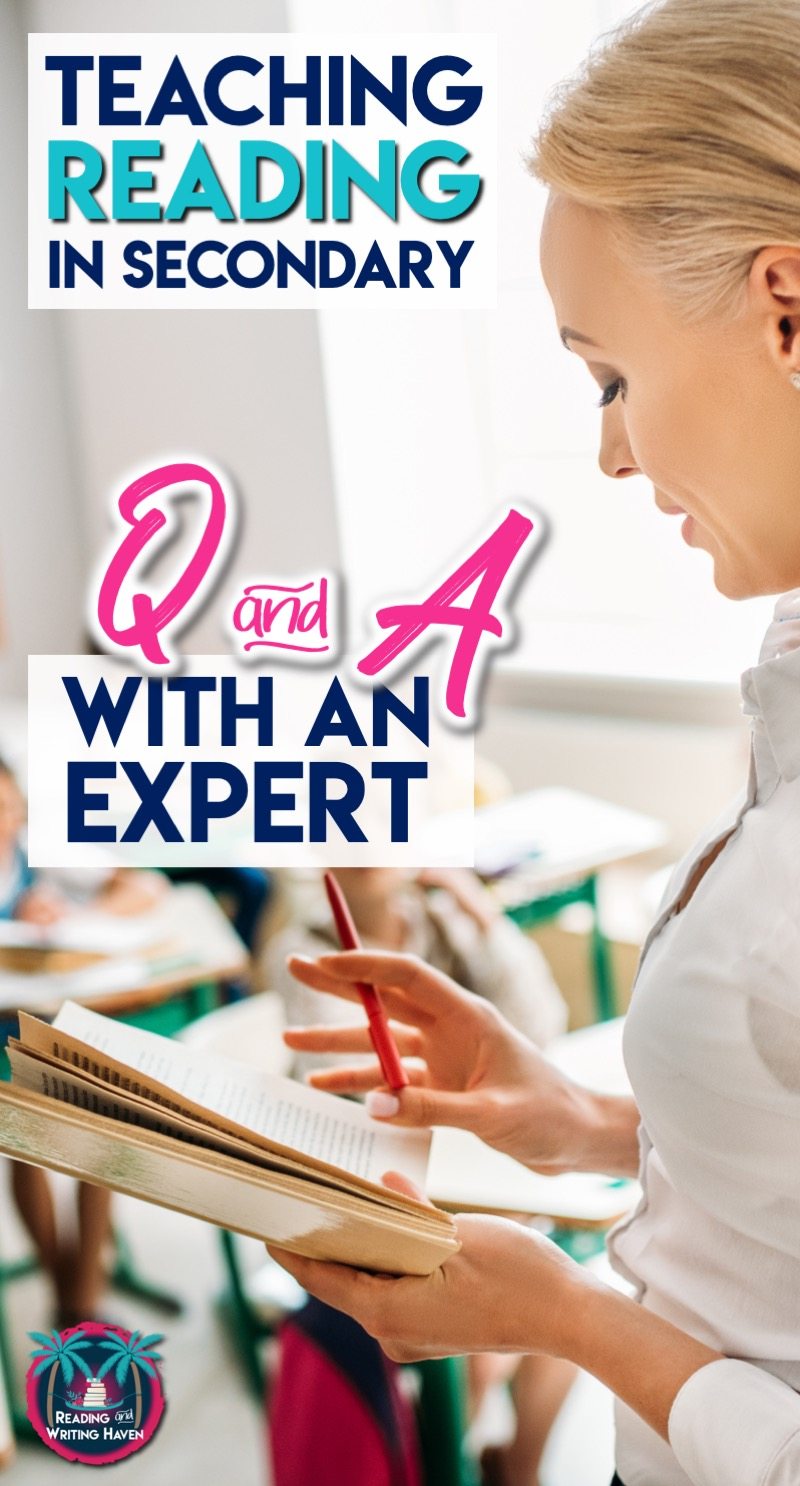How to Address Gaps in Reading Comprehension in High School
Confused about how to teach reading or how to address reading comprehension issues in high school? You’re not alone! Here are answers you can trust from an expert in the field. Some of the most pressing questions secondary teachers have about addressing reading comprehension in high school — demystified.
For this post, I wanted to interview an expert…someone who undoubtedly has lived these issues, researched them, and found practical ways of addressing reading comprehension in the secondary classroom. So, I contacted Dr. Haling, my advisor and professor during my graduate reading training.
College professors are busy, so I was worried she might not have time to respond to the weightiness of these questions, which were posed by a group of highly motivated secondary teachers who truly want to know the answers. Luckily for us, she agreed to help. What follows are Dr. Haling’s responses to eight of the most frequently asked questions regarding how to address reading comprehension in high school.

An Expert’s Views on Reading Comprehension in High School
#1
Question: Currently, there are many different philosophies about effective reading instruction in secondary school. Independent reading, silent sustained reading, literature circles, student-choice reading, and instruction of whole-class novels. What is your advice regarding the best methods for addressing and incorporating reading at the high school level?
Answer: Readers of all ages need the same thing: instruction that focuses on meaning making. Secondary teachers are in a difficult position because by the time students get to them, each student’s reader identity has likely already been set. If readers believed that they were not good readers in the early grades, they will believe they are bad readers when they get to high school. If they didn’t experience the joys of reading early on, they are likely not going to find enjoyment in reading at the high school level.
Therefore, it is really important for secondary teachers to incorporate a variety of instructional approaches that help to counteract a negative reader identity. Each of the approaches you list above should be included throughout the year. All of the approaches should include student choice. We do know that students value choice in reading above all else.
#2
Question: Most high school teachers are not certified reading specialists. Can you offer some guidance regarding when and how to assess reading comprehension in the classroom?
Answer: The most important thing to remember about assessing comprehension is that not all readers will construct the same meaning around one text, and not all readers will remember the same details. If teachers give a test with questions they developed, all they can say with certainty is whether the student could “remember” the answers to those specific questions. A test does not tell teachers what other information the student can recall from the text or what other meaning was constructed.
A reading conference in which the teacher has a conversation with the student about what he/she read is the best way to assess comprehension. Reading conferences are not generally a practice that takes place in high school, but using some of the instructional methods you mention (independent reading, literature circles, etc.) provide more flexibility for the teacher to work with student one-on-one.
In terms of when to assess, I think that is a little trickier, because it would depend on the complexity of the reading material, probably even the length of the text, and how much scaffolding is needed based on students’ background knowledge of the text.
We do need to ask ourselves about the purpose of short quizzes after reading assignments. Are these to measure comprehension, or are they to see if the students read the assigned pages? If it’s the latter, I would argue that that is really not a good measure of comprehension.
#3
Question: What are the most effective ways to differentiate for multiple reading levels in a mixed ability class?
Answer: Use a variety of texts, provide a lot of background information related to what is to be read, and incorporate a variety of reading activities (shared reading, reading aloud, audio versions of the text, silent reading, etc.).
Never ask students to read aloud in front of the class unless they have had an opportunity to “rehearse” the text before reading aloud. Reading researchers have argued for over 25 years that round robin reading (and other practices like it, such as popcorn reading) is a detrimental instructional practice, especially when you think about the need to foster positive reader identities. If teachers want to have students read the text aloud, they should allow students a short time to rehearse the passage.
#4
Question: Many teachers use novels, such as To Kill a Mockingbird, as a class text. Some districts require that everyone read the original text, not an abridged version or a graphic novel. Teachers try to scaffold lessons by reading to students, summarizing along the way, and using comprehension questions. Students also take notes while reading. Still, it always seems like there are a handful of students who can’t remember anything, even basic information — like which character is Boo. How can high school teachers help these students?
Answer: Providing a lot of scaffolding to support students’ construction of meaning is important, and from the context in the question, it sounds like that is already being done.
Sometimes with classics, even though English teachers love them, some students just don’t experience the same pleasure from reading them, and they have a hard time making connections to their own lives. One text for the whole class is never going to be of same interest and level for all the students in the classroom. Never!
One thing you can try is to have students try to make these connections along the way. Connect the themes in the text to current events. You could also try showing the movie first so that they at least have a general idea of what the story is about.
#5
Question: What books on reading comprehension would you recommend ALL secondary teachers read in order to inform and improve their instruction, and why do you recommend this / these title(s)?
Answer: I would recommend anything by Cris Tovani, such as I Read it But I Don’t Get It. Tovani has a lot of experience working with high school readers and gives very practical ideas for incorporating reading instruction into any content area. Kelly Gallagher (although his are mostly on writing) has a book called Deeper Reading that also speaks to instruction in high school settings.
#6
Question: Recently, questions have been raised about whether we are asking students to do too much while they read (through reading guides, annotating, and etcetera). Some argue that these tasks kill students’ love for reading. Do you agree or disagree? Do secondary students need to be asked to respond in written formats to texts as they read? Or should we just let them read without formal accountability?
Answer: Kelly Gallagher talks about this very thing in his book. I do think that we can get carried away with the multiple ways in which we disrupt readers’ thinking and reading by requiring tasks and assignments. I think that readers who have a harder time with comprehension may want use strategies, such as reading guides, annotating, etc. along the way, but proficient readers are likely to only find these assignments as busy work.
#7
Question: Are there any best-practices in reading that every teacher should be incorporating in their lessons or curriculum?
Answer: Yes, student choice in what they read!
#8
Question: As a university professor of bachelor, masters, and doctoral level classes, where do you observe gaps or missing skills regarding reading comprehension? What can high school teachers further emphasize or focus on in order to more adequately prepare students for post-secondary education?
Answer: I think the biggest thing is for secondary teachers to recognize that reading instruction cannot stop even in high school. Every year in school, texts become more complex, and they demand more sophisticated reading strategies. Therefore, reading instruction should focus each year on the complexity of the texts that students are expected to read. Learning to be a better reader never stops.
Also, reading instruction always has to emphasize meaning making. If readers cannot comprehend (talk about what they read) then it’s not really reading.
What’s more, each content expert in the school needs to recognize that he/she knows best how to help students read and understand the texts in their discipline. When this instruction falls only on the English or Reading teacher, students don’t get what they need because the English teacher has his/her own genres of texts that are completely different from what students read in almost every other subject. The English teacher should not have to be an expert on HOW to read science texts to learn science, for example.
Finally, I would suggest that a gap I see in undergraduate and graduate students is that many do not really know how to interact with the texts they read to construct meaning beyond a very surface-level understanding. Part of this could be because textbooks can be very boring, and they are not typically authentic texts that one would read in any other context outside of the classroom. Therefore, I suggest using authentic texts that illustrate the concepts on which the teacher is focusing.
RELATED READING:
- Helping Students Select Just Right Books
- Getting to Know Your Readers
- Assessing Comprehension without Making Students Hate Reading
- How to Run Classroom Book Clubs
About Dr. Haling:
Linda Haling is the current Dean of the College of Education and Health Services at the University of Wisconsin. She is also the former director of the School of Teaching and Learning at Illinois State University. She has previously taught both graduate and undergraduate courses in reading assessment and early adolescent literacy learning. Linda is a former middle school teacher and reading specialist.
She has extensively researched self-selection of books and adolescent literature. She is the recipient of the Clarence W. Sorensen Distinguished Dissertation Award and the Mary S. Arnold Research Award. She has authored book chapters in addition to articles that have appeared in Voices from the Middle and The Reading Teacher. She is lead author on Broadening the Lens of Literacy in the Content Areas published by Kendall Hunt.
If you have questions about reading or reading comprehension, you are invited to contact Dr. Haling at [email protected].


Love this! I have a lot of students who struggle with reader identity. Some even claim they cannot read. They can, but it’s so hard to change that mentality once they are in high school; it’s so ingrained by that point. I really like the idea of quick one-on-one conferences to gauge reading comprehension instead of quizzes. I’m not sure how, but I will definitely be implementing that this fall. Thanks for the great info!!
I can totally relate! Thanks so much for sharing your experiences. Please let me know how the one-on-one conferences go. 🙂